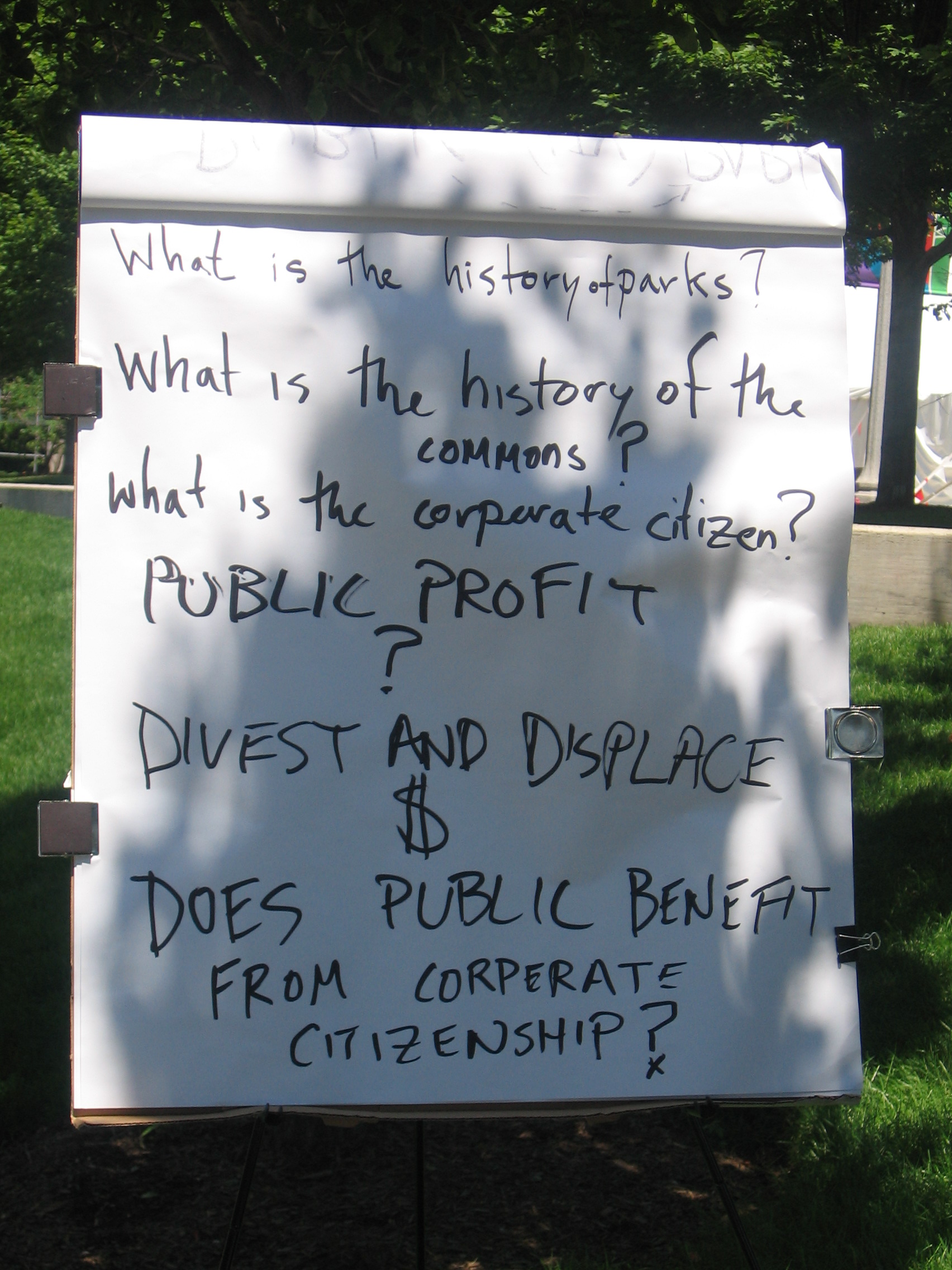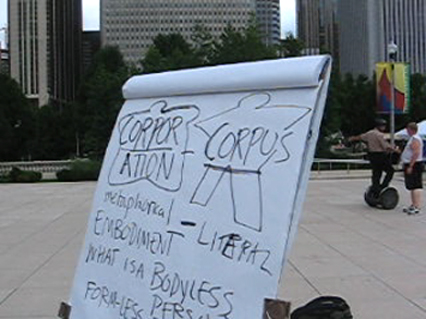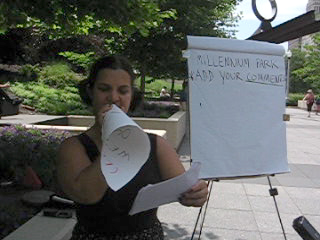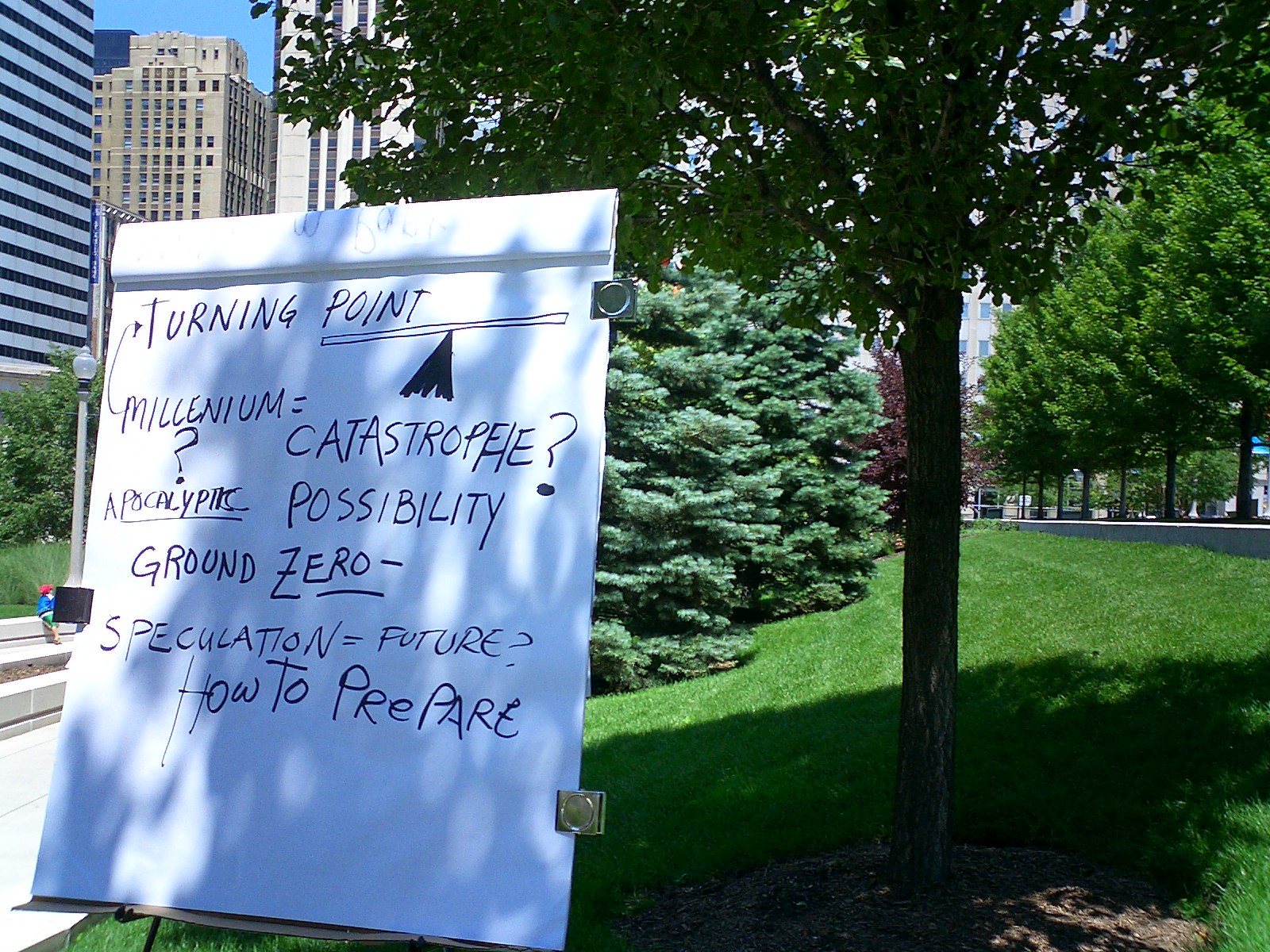Report: A Meeting is a Question Between – BLW
I think this small video can be a good place to start an initial, quick report of BLW’s week of public meetings in Millennium Park, July 1-5, our contribution to the Pathogeographies exhibition (see HERE for more details). There is, from the beginning, a sense that the overwhelming imperative for positivity exposes us to something damaging, to a kind of suffering. As people who are visibly struggling with the performance of exceptional enjoyment, we receive some helpful advice: click HERE to watch the video, and pls be patient…
Over the duration of a week, we settle into a peculiar routine, which formalizes our activities as a kind of “work” (?)
8AM – wake up, prepare for meeting, set agenda; 10AM – freak out; 10:30AM – pack all necessary materials for the day; 11AM – depart for Millennium park; 11:45 – select exact location in park and set-up for meeting; noon-ish – 2-ish – conduct meeting; 3PM – return to our base, review the day’s meeting and begin plans for the next day
following is a nonsequential agenda of the proceedings.
The Millennium – What is a Turning Point?
Inaugural presentation by Sarah on the first meeting, accompanied by exercises in turning/spinning — to turn is to bring equilibrium into question; it is also to see in different directions; the acquisition of multiple frames from the same vantage point; a certain velocity of the landscape without traveling through it; the confusion of distances; becoming disoriented. The question of our (dis)orientation is revisited in subsequent meetings.
.
.





What is a Public Park?
the extraction of profit from the commons – but what is the commons??
.
A Chicago family joins us in a discussion provoked by Sara’s presentation and the question: “Is this a Public Park?”. Click HERE for a map showing the land designated as a common, to be held in trust by the State. Recorded on July 2, 1836, the text on the map reads: “Public Ground. A common, to remain forever open, clear and free of any building or obstruction whateverâ€. The economic argument has lead to a series of court decisions and development schemes over the last century and a half, so that now we are sitting on in the grass on a rooftop terrace, with two stories beneath us: the train station and the garage. We are unsure how to understand “land” in the peculiar material and symbolic conditions of Millennium Park.
.
.
Questions for further research and deliberation, as summarized by Duskin. We return to some of these in subsequent meetings.
.
.
.
.
This is the Bean – What is the Bean? Exercises at the SBC Plaza
CORPoration – CORPus
What is a bodyless person?
Click HERE for a short video of Julie’s presentation on the corpus of the corporation, self-interest and pleasure, and our attempts to reflect the Bean back to itself. This was a two-part presentation, beginning with a July 2nd exercise, reconsidered and expanded at the July 4th meeting.
.


.

What is a public debate? Recitations at the Chase Promenade
For over a year the blogosphere was abuzz with heated debates surrounding Millennium Park. Users of online forums commented on the social uses of the park; beauty and cleanliness and safety; civic pride and other forms of identification/belonging; the spectacle of children’s pleasure; the obfuscation of poverty; the patro(izing) corporation and so on. BLW conducts public recitations of several dozen such online comments in the park, along the Chase Promenade. We also ask passers-by to offer their own written comments for us to read. Click HERE and HERE for short video/audio excerpts.
.
 What is warfare? (Dis)orientations in the Boeing Gallery
What is warfare? (Dis)orientations in the Boeing Gallery
Between 1994-1996, “Rapid Dominance†was formalized as the new paradigm for American warfare, translating into military combat the structural realities of the commercial sector. “Rapid†refers to “owning the dimension of timeâ€, the ability to accelerate/decelerate processes, to produce temporal confusion. “Dominance†refers to “total situational awareness†– total understanding of self, adversary and environment; and the ability to paralyze, confuse or overload the adversary’s capacity to understand themselves within the situation. “Rapid Dominance†implies achieving psychological and affective effects, the real-time manipulation of senses and inputs to compel the enemy to accept one’s strategic aims.
The ability to destroy underscores RD, but the application of physical force may not be necessary. If RD is an extension of corporate governance and the new economy, what kind of battlefield is Millennium Park, and are we enemy subjects? How are we disoriented, overloaded, paralyzed, confused? “Shock and Awe†is one of the better known affective configurations of RD. Rozalinda hypothesizes “Lull and Awe†as the method deployed upon/through us in Millennium Park. Her presentation along the Boeing Gallery is a series of exercises in re-orientation.
 This includes demonstrations on how to calculate the cost per kill of the new generation of Boeing solid state lasers; a discussion of simultaneous temporal compressions/expansions specific to the production of leisure; a demonstration on the coincidence of the aesthetic and violence in the next generation Boeing spy satellite technology, the relationship between resolution and extending the time of kill.
This includes demonstrations on how to calculate the cost per kill of the new generation of Boeing solid state lasers; a discussion of simultaneous temporal compressions/expansions specific to the production of leisure; a demonstration on the coincidence of the aesthetic and violence in the next generation Boeing spy satellite technology, the relationship between resolution and extending the time of kill.
 What is a Public Park (revisited)?
What is a Public Park (revisited)?
What is the Commons?
Discussion along the Chase Promenade
Sarah revisits a series of questions related to the history and symbolic function of parks, especially in relation to power and identification, as well as the history of the commons beginning with English law. This helps us return to the question of the land — here, in terms of ownership and use/access.
Click HERE for a short excerpt of our discussions, a kind of amateur legal forensics. We struggle to learn together, to identify the key places we should look to for different understandings of personhood in relation to land and ecology, livelyhood in relation to community.
What do You Want?
Rainbow of Desire workshops between the Chase Promenade and the Pritzkler Pavilion
In this workshop, Jeremy leads us through a set of structured activities which utilize collaborative work to explore, enact and problem-solve. Part of the Theater of the Oppressed method developed by Augusto Boal, rainbow work seems to be especially relevant to people living in conditions where the structures of oppression are difficult to detect and understand. This kind of body work is not only about exteriorizing or making visible, but also about co-participation in creating solutions. For the first few exercises, we are joined by passers-by, including a group from Hyde Park Art Center. As the work becomes more intense, difficult and (self)confrontational, workshop participation drops to 5, then 4, and we end with three.

 Filed under: Places: BLW
Filed under: Places: BLW
Comments Off on Report: A Meeting is a Question Between – BLW






